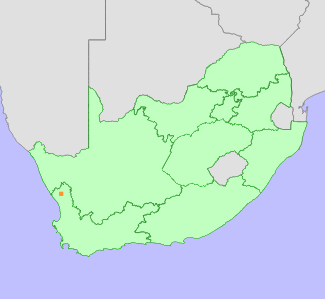|
Scientific Name | Bulbine lolita S.A.Hammer |
Higher Classification | Monocotyledons |
Family | ASPHODELACEAE |
National Status |
Status and Criteria | Critically Endangered A2ad+4ad; B1ab(v)+2ab(v) |
Assessment Date | 2022/06/24 |
Assessor(s) | N.N. Mhlongo, N.A. Helme, A. Harrower & D. Raimondo |
Justification | This species is a highly restricted endemic known from a single location in the Western Cape province. It has an extent of occurrence (EOO) and an area of occupancy (AOO) of less than 10 km². This dwarf succulent has been increasingly targeted by illegal collection and is in high demand by collectors. The continued threat of illegal collection remains very high with the single location rendering the species highly susceptible to further rapid decline due to this activity. A decline of 80% has been observed in the past two years and it is projected that a further decline of 50% will occur within the next 13 years (generation length of 5 years). It therefore qualifies as Critically Endangered under criteria A and B. |
Distribution |
Endemism | South African endemic |
Provincial distribution | Western Cape |
Range | This dwarf succulent species is a South African endemic occupying a highly range-restricted area in the Western Cape province. It is known only from a small area in the Knersvlakte. |
Habitat and Ecology |
Major system | Terrestrial |
Major habitats | Southern Namaqualand Quartzite Klipkoppe Shrubland |
Description | Plants grow on a hillrock of decomposed gneiss. |
Threats |
| This attractive miniature succulent is highly threatened by illegal collecting to supply the succulent trade. The population is declining rapidly as a result of illegal collection with over 4900 plants included in confiscations in 2022, many more are likely to have been removed from the wild but not intercepted by law enforcement efforts. |
Population |
A rare and very poorly known species. It is currently known from one location consisting of three subpopulations, which all lie within 3 kilometres of each other. Population size estimates are only available for one subpopulation, where the number of plants was thought to be less than 500. CapeNature recently confiscated more than 4000 plants, suggesting that other subpopulations may exist in suitable habitat in the surrounding area. As it stands, the population size is unknown but the population is suspected to be declining rapidly due to illegal collection. The population has experienced a loss of 80% in the past two years due to illegal collection and it is projected that an additional 50% will be lost in the next 13 years.
|
Population trend | Decreasing |
Assessment History |
Taxon assessed |
Status and Criteria |
Citation/Red List version | | Bulbine lolita S.A.Hammer | DDD | 2017.1 | | Bulbine lolita S.A.Hammer | Least Concern | Raimondo et al. (2009) | |
Bibliography |
Hammer, S. 2006. Bulbine lolita: A pearl-skinned beauty from the Knersvlakte. Cactus and Succulent Journal 78(2):70-73.
Raimondo, D., von Staden, L., Foden, W., Victor, J.E., Helme, N.A., Turner, R.C., Kamundi, D.A. and Manyama, P.A. 2009. Red List of South African Plants. Strelitzia 25. South African National Biodiversity Institute, Pretoria.
Snijman, D.A. 2013. Plants of the Greater Cape Floristic Region 2: The extra Cape flora. Strelitzia 30. South African National Biodiversity Institute, Pretoria.
|
Citation |
| Mhlongo, N.N., Helme, N.A., Harrower, A. & Raimondo, D. 2022. Bulbine lolita S.A.Hammer. National Assessment: Red List of South African Plants version 2024.1. Accessed on 2025/10/28 |
 Comment on this assessment
Comment on this assessment


